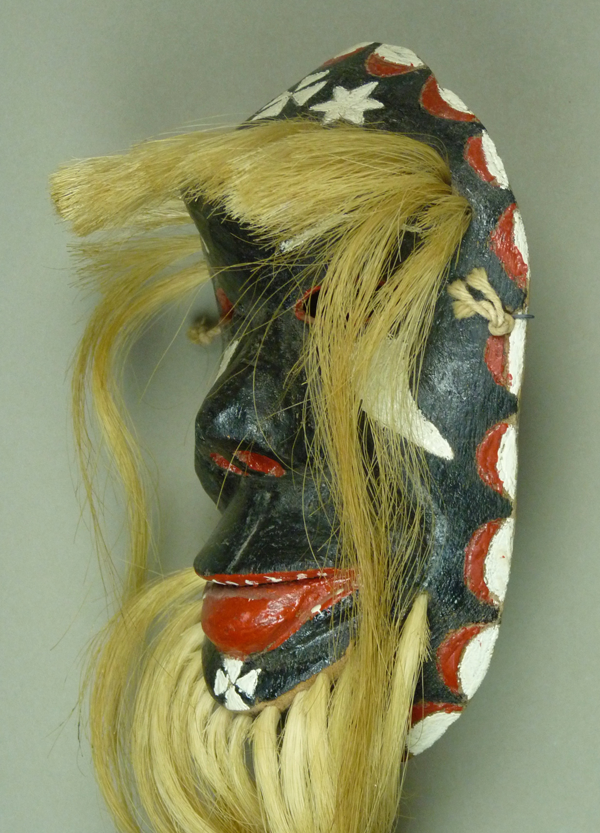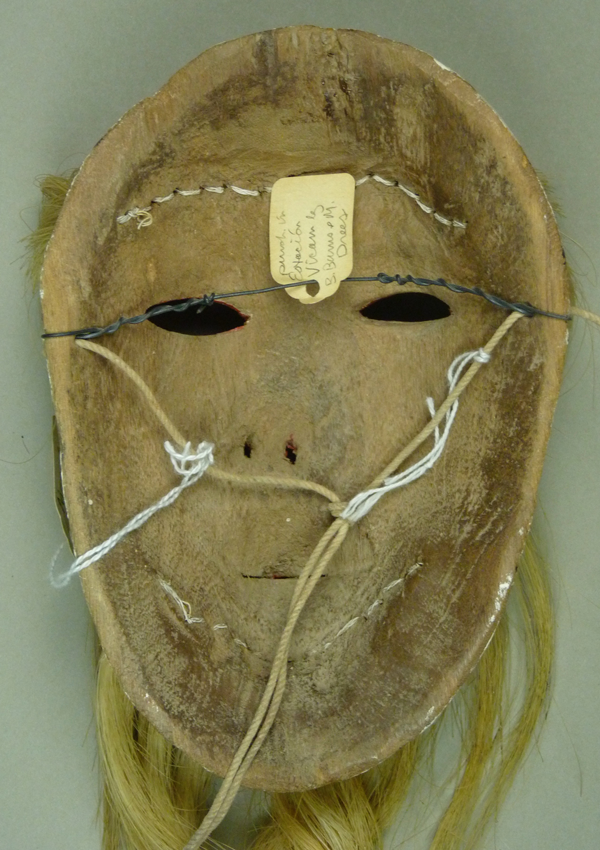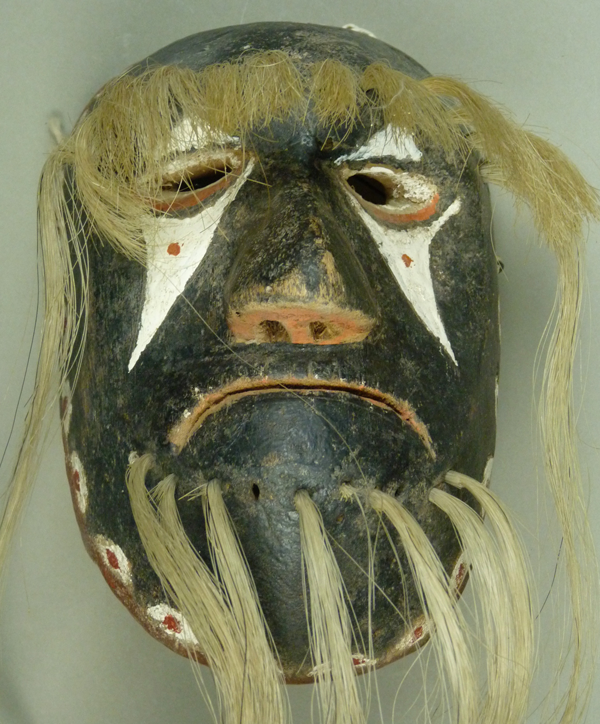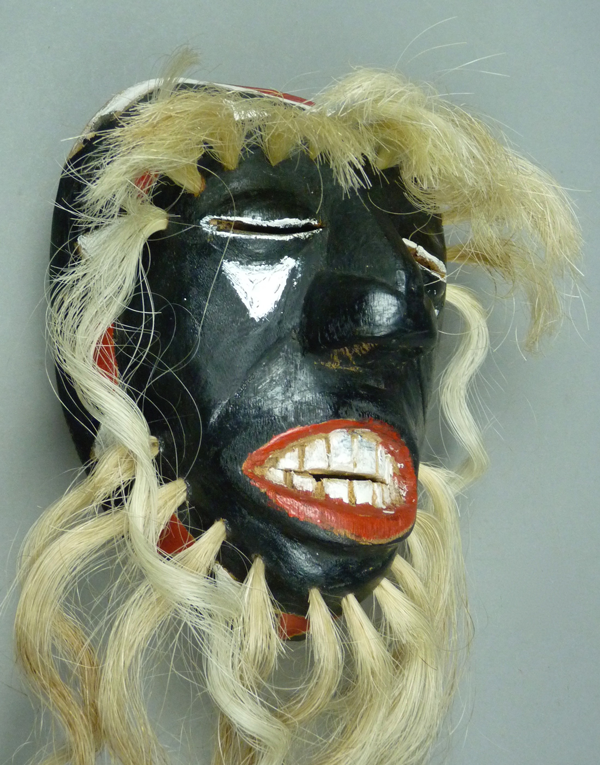In last week’s post I showed some terrific human faced masks by Manuel Centella Escalante. This week I will round out your exposure with a few more remarkable examples, along with others that may seem less impressive, but they extend our awareness of Centella’s range of features.
The four masks that lead off in today’s post were photographed from the collection of David West, the owner of the Gallery West in Tucson, Arizona; I thank him for his helpful support. The first of these is a particularly elegant example. It was purchased in Sonora by a tourist, who later sold it in 1960 to Tom Bahti, a Tucson Indian arts dealer. Given the impressive wear on the back, this mask could easily date to 1950 or earlier. Painted decoration such as the white triangles under the eyes and parts of the rim design were not outlined with inscribed lines, but instead with pricked or “pecked” lines. I have seen this on no other Centella mask. The mouth, with lips like those of some female movie star, is also unusual.
The rim design is also elegant; I call it Centella’s “drapery” rim design, because it reminds me of the swags interior designers place around windows. In this side view the pricked design around the triangles under the eyes is particularly easy to see.
From above the drapery style rim design is particularly visible. Also one can see Centella’s typical cross design, the triangles outlined by inscribed lines but obscured by sloppy repainting.
Also one can see the density of hair tufts that is common on Centella’s masks.
The staining on the back of this mask suggests heavy use.
The second mask is rather unusual for Centella, but on reflection, Tom Kolaz and I can not imagine that it could have been carved by anyone else.
One design feature that is typical for Manual Centella was to place a triangle of contrasting color within the primary triangle under each eye.
This extreme humped nose has been seen on other Centella masks, but it is uncommon.
The rim design on this mask is unusually spare. The forehead cross is slightly different from Centella’s usual design.
There are triangles over the eyes, a well known Centella feature.
There is no chin cross, which is unusual for Centella’s human faced masks.
Look at the wear on this back. It was said to have been danced for just 6 years! The label reminds us that this mask appears on a dancer’s face in a dance photo (Arizona Highways, April 1977, page 9).
The next mask is generally more conventional and familiar, except that Centella did not usually carve human faced masks with extended tongues, making this one a refreshing variation. I suppose it is possible that this mask represents an ape (a Chango).
There is no mistaking Centella’s typical forehead cross, and flanked by his usual segmented six pointed stars.
Likewise the rim design is by now quite familiar to you.
The chin cross is typical. What I really like about this photo is the design of the (ape-like) face that greets the viewer from this angle.
The wear on the back of this mask is fairly extreme.
We might call the next mask an example of Centella’s Viejo style; I have seen several of these. For example there is one like this in the collection of the Arizona State Museum in Tucson, Arizona.
The mouth conveys a serious expression.
I really like the simplicity of this style.
There is the usual rim design and forehead cross.
But there is no chin cross.
Here is yet another heavily danced back.
I included this next mask from my collection as an example of Centella’s mainstream human faced masks. From top to bottom, everything about this mask is rather typical of Centella’s work. I bought this mask on EBay™ in 2001.
Note the sagging bottom of the nose, a feature seen in varying degrees on Centella’s masks.
The forehead cross, the chin cross, the triangles over the eyes, the rim design, and the oversized nose are all typical for Centella.
This mask is 8 inches tall, 6 inches wide, and 4 inches deep.
The wear on this mask is very mild.
Here is a similar mask, from the Caskey Lees collection (in San Francisco), photos courtesy of Liz Lees. It differs from the last in its patina, and has an elegance that sets it apart.
The front view reveals all of the expected and classic design elements of a Manuel Centella mask.
From the side, we see this magnificent nose, so simple and grand, and polished by use.
Tom Kolaz collected the last mask in this post in 1979 from a dancer in Sonora, who stated that it was carved by Manuel Centella. I purchased it from Tom because of an interesting design detail, that of the vision slits (crescent shaped openings under bulging eyelids). Tom Kolaz and I have seen this feature on only a few of Centella’s masks, and occasionally Preciliano Rodríguez Cupis and Conrado Rodríguez Cupis have carved more limited versions of these slits under the eyes.
After all of these masks with typical features, here is one that is generally atypical, apart from the nose and mouth.
The eyes appear to be made of rubber, when of course they have been carefully carved from Cottonwood root.
The painted and inscribed designs on the forehead are highly unusual. The border design has been pushed in from the edge. There is no forehead cross.
Nor is there any chin cross.
This mask is 7½ inches tall, 5¾ inches wide, and 3½ inches deep.
There is mild staining from use. At least the back looks like the work of Centella.
Next week I will focus on Goat faced masks by Manuel Centella Escalante.































